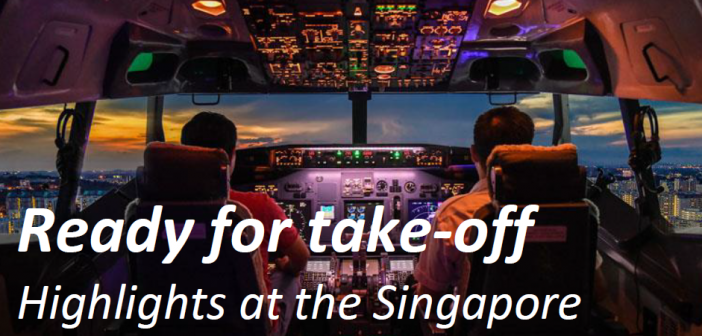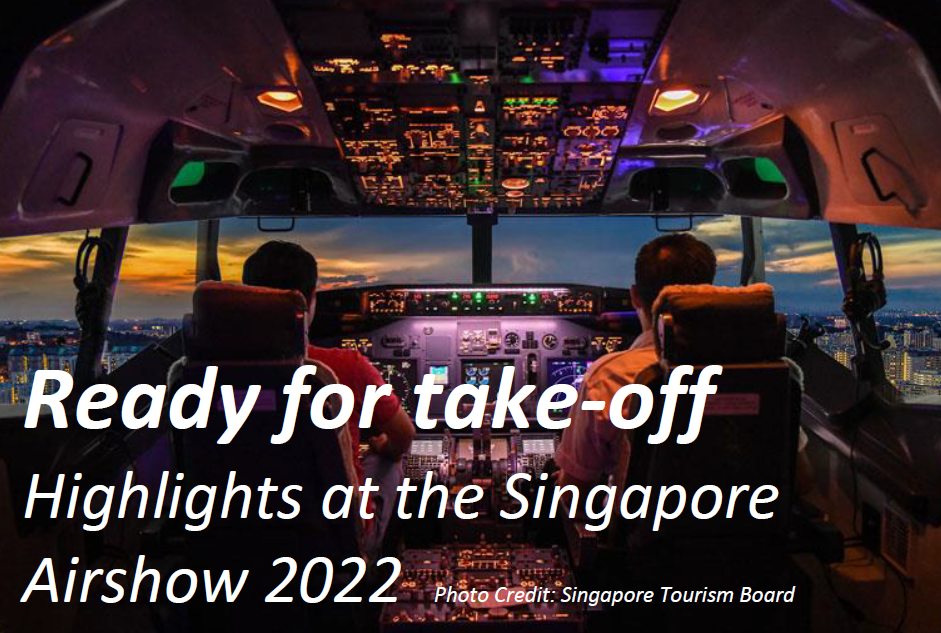
Two years ago, the 7th edition of the Singapore Airshow was one of the last major physical events before the world was hit hard by the pandemic, which severely disrupted the aviation sector.
At its peak, international passenger traffic shrank by more than 90%, with passenger traffic at Singapore Changi Airport falling to less than 1% of pre-COVID levels, and global spending on aerospace MRO (maintenance, repairs, overhauls) dropping by over 40% in 2020.
Without a doubt, the last two years had been one of unprecedented challenge for the sector.
With signs promising recovery in the near horizon – such as Vaccinated Travel Lanes (VTL) for travellers from more than 20 countries – the 8th edition, held from 15-18th Feb 2022, is a much welcome opportunity to showcase the innovations reshaping the industry as it gears up to meet the anticipated uptick in demand.
Representing more than 70% of the top 20 global aerospace companies with almost 600 participating companies from more than 39 countries/regions, the SIngapore Airshow 2022 reflects the return of air travel in many ways.
Recovery and safe re-opening
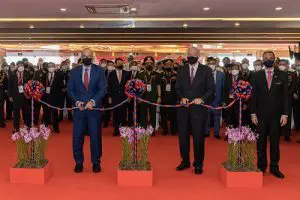
“(L-R) Mr S Iswaran, Minister for Transport and Minister-in-charge of Trade Relations, Dr Ng Eng Hen, Minister for Defence and Mr Ravinder Singh, Chairman of Experia at the Ribbon-Cutting Ceremony of SIngapore Airshow 2022. Photo credit: SIngapore Airshow 2022”
“Two years on, as we learn to live with the virus, countries are gradually re-opening their borders. International air travel passenger volume is expected to recover to 55% of pre-COVID levels this year, up from about 20% in 2021,” said Mr Heng Swee Keat (Deputy Prime Minister (DPM), Coordinating Minister for Economic Policies, Singapore) at his opening speech.
Reflecting Singapore’s commitment to safely re-open the economy and borders to the rest of the world, the Airshow trialled new protocols (a higher event capacity and daily COVID-19 testing), to pave the way for the safe and calibrated resumption of larger conferences, and exhibitions.
“All attendees will have to be pre-registered, fully-vaccinated with the World Health Organisation Emergency Use Listing (WHO EUL) vaccines and adhere to the prevailing safe management measures. These include mandatory mask-wearing, safe distancing protocols, designated food and beverage zones and regular disinfection of event spaces,” said Mr Leck (Managing Director, Experia, SIngapore Airshow 2022 organiser).
Transformation drivers – digitalisation and sustainability
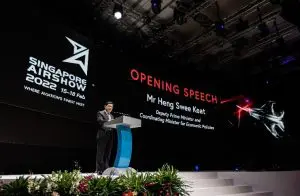
“Deputy Prime Minister and Coordinating Minister for Economic Policies Mr Heng Swee Keat delivering the opening address at the Opening Ceremony of SIngapore Airshow 2022. Photo Credit: SIngapore Airshow 2022”
In addition, reflecting Singapore’s commitment to grow the sector – there are several developments to transform the sector with the twin drivers of digitalisation and sustainability.
Digitalisation initiatives include the aviation lab launched by Singapore Airlines and the National University of Singapore to explore AI and data science, and the 320 hectare Selatar AeroSpace park to host “plug & play” smart factory solutions for advanced aerospace manufacturing and MRO (maintenance, repairs, overhaul) activities.
Singapore’s multi-prong approach to meet sustainability goals such as net-zero carbon emissions by 2050 includes piloting the use of sustainable aviation fuels at Changi Airport. Other examples are the MOU signed by the Civil Aviation Authority of Singapore (CAAS) with Airbus to collaborate on sustainable aviation;

“SIngapore Airshow 2022. 15 – 18 February 2022, Singapore Changi Exhibition Centre. Photo Credit: ST Engineering.”
Neste’s expansion of its Singapore’s refinery to produce sustainable aviation fuel at commercial scale (up to 1 million tons annually when completed in 2023); and SIngapore Airshow’s inaugural “Sustainable Aviation Forum” to discuss future technology, air mobility and aviation operations.
Autonomy and Air mobility
There is certainly much excitement over autonomy and air mobility.
In fact, autonomous aircraft technologies have long been identified as key to realising Singapore’s Smart Nation initiative, with the passing of the “Unmanned Aircraft (Public Safety and Security) Act 2015.”
However, what is increasingly evident is its role in contributing to the digitalisation and sustainable agenda.
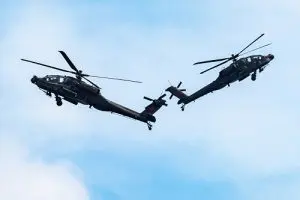
“The RSAF’s aerial display will feature nine manoeuvres by the F-16C fighter aircraft and 12 manoeuvres by the pair of AH-64D Apache attack helicopters. Photo Credit: SIngapore Airshow 2022”
Emphasising the technologies as a “potential gamechanger”, DPM Heng pointed to how they could improve “how we guide and control aircrafts, and eventually, to transport cargo and people around autonomously.”
In particular, Teong Soo Soon (VP & Head of UA Systems at ST Engineering) said Unmanned Aircraft Systems (UA) are emerging “as safe and robust alternatives to traditionally labour- and time-intensive missions.”
The recent deployment of drones for crowd management and search and rescue, and for water quality monitoring and survey are examples where the public sectors have seized on the potential of the technologies to reduce man-power – and to act as early warning systems.
Announced at the SIngapore Airshow 2022 was another deployment of UA – in heavy-lift ship-to-shore parcel delivery. The 9-month pilot involves a consortium of ST Engineering, Sumitomo Corporation and Skyports to conduct Beyond Visual Line of Sight (BVLOS) flight operations using ST Engineering’s DroNet, with the goal of establishing a UA delivery network capable of carrying parcel payloads up to 10kg.
Adding to the buzz of UA talk is the progress in electrical vertical take-off and landing (eVTOL).
Since Volocopter first captured the Singapore public’s imagination with its eVTOL flight over Marina Bay in 2019, there had been several developments of significance in the sector.
During the SIngapore Airshow 2022, Volocopter announced that it is targeting a commercial launch in Singapore around 2024 and has released its “Singapore Roadmap” – one of the fist places in the world in which the company will operate.
Skyports’ expertise and experience of providing the critical link between the ground and the sky through the design and development of take-off and landing sites – vertiports – for eVTOL will be leveraged in multiple projects. In particular, Skyports signed an MOU with several government agencies in Singapore for further research and development work, which includes the provision of an air taxi vertiport terminal, airside facilities and hangarage, and UA pilot training.
However, sharing a common and busy air space for the safe operations of manned and unmanned aircraft is not without challenges.
For example, today’s regulations set out height restrictions and geofencing rules for drones – such as Singapore’s rules that drones must not fly within the specified distance of 5 kilometers (3.1 miles) of an airport.
To spur UA adoption and scale up for commercial operations, a crucial development is the safe integration of UA into a non-segregated airspace.
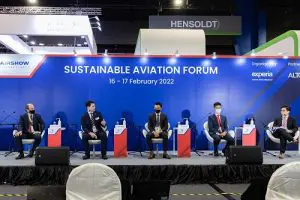
“Sustainable Aviation Forum Day 1 – (L-R) Fernando Ariño Grau (Director of Market Intelligence, Embraer Asia Pacific, Embraer Commercial Aviation), Matheu Parr (Customer Director, Rolls-Royce Electrical), Tay Yun Yuan (Head of Asia Pacific, Skyports), Tan Kah Han, (Senior Director, Unmanned Systems Group, Civil Aviation Authority of Singapore – CAAS); Joshua Ng (Director, Alton Aviation Consultancy, moderator). Photo Credit: SIngapore Airshow 2022”
Speaking at the “Sustainable Aviation Forum – Day 1”, Tan Kah Han (Senior Director, Unmanned Systems Group, CAAS) laid out three phases to “interface then integrate to enable AAM (advanced air mobility) operations” from a regulatory perspective.
The approach sees regulations in today’s segregated airspace replaced progressively by a “UTM & ATM Convergence” (unmanned traffic management and air traffic management) in the near term with the deployment of drones delivery, and an “UTM & ATM integrated Airspace” in the future with the launch of eVTOLs.
CAAS is also working with universities and other partners, to further ATM research using digital and other tools. Demonstrating the importance of public-private partnership, an MOU was also inked with ST Engineering Aerospace Ltd at the SIngapore Airshow 2022 to jointly advance UA technologies development and adoption in Singapore.
Ready for take-off
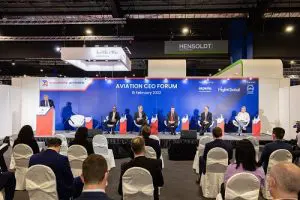
“(L-R) FlightGlobal’s contributing editor Mark Pilling, Bo Lingam (Group CEO, AirAsia Aviation Limited), Dómhnal Slattery (CEO, Avolon), Robert Martin (Managing Director and CEO, BOC Aviation), Gaël Méheust (President & CEO, CFM International), Lim Kim Hai (Executive Chairman, REX Airlines), speaking at the Aviation CEO Forum at Singapore Airshow 2022. Photo Credit: SIngapore Airshow 2022.”
The recovery of the industry is another topic that takes centre-stage at this year’s Airshow.
Notwithstanding potential headwinds such as rising oil prices and overall price inflation, leaders at the “Aviation CEO Forum” (Avolon, BOC Aviation, CFM International, Malaysia Airlines, Air Asia Aviation Group, Rex Airlines) expressed cautious optimism for the sector’s recovery.
The role of the aviation in driving the economy and bringing people together is clear.
The sector “has a strong multiplier effect on adjacent industries, including logistics, hospitality and professional services”, and it “also brings billions of people together. People travel by air to visit friends and loved ones, and to explore interesting sights and cultures around the world. Aviation has helped to deepen shared perspectives of our common humanity,” said DPM Heng at his opening speech at the Singapore Air Show 2022.
“Hence, we should resolve to bring aviation and aerospace to new heights as we rebuild for a better post-pandemic future,” he added.
Indeed, with aerial displays of incredible stunts and manoeuvres from the Republic of Singapore Air Force, the United States Marine Corps and the United States Air Force, the Indonesian Air Force and the Indian Air Force, there is much enthusiasm in the air as the sector readies for take-off.

